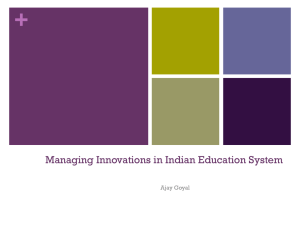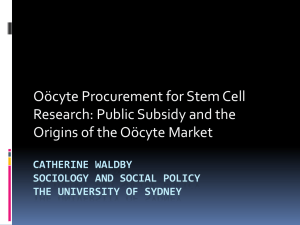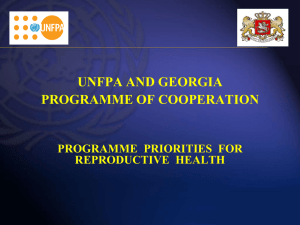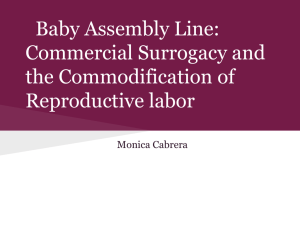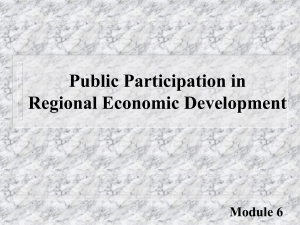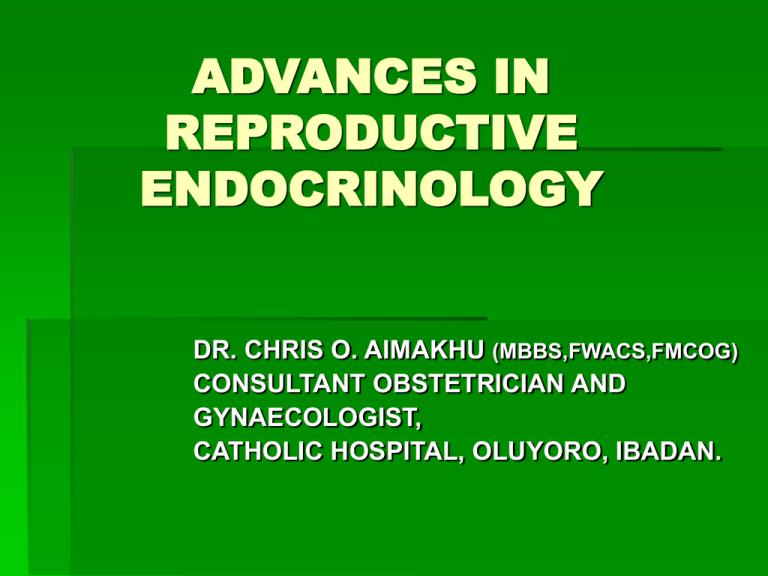
ADVANCES IN
REPRODUCTIVE
ENDOCRINOLOGY
DR. CHRIS O. AIMAKHU (MBBS,FWACS,FMCOG)
CONSULTANT OBSTETRICIAN AND
GYNAECOLOGIST,
CATHOLIC HOSPITAL, OLUYORO, IBADAN.
REPRODUCTIVE
ENDOCRINOLOGY
---Provides comprehensive care for a wide range
of reproductive problems.
---Common problems evaluated and treated
include: Infertility (primary and secondary)
Pregnancy loss
General female hormonal disorders
Hirsutism (excessive hair growth)
Menopausal symptoms
Endometriosis
REPRODUCTIVE
ENDOCRINOLOGY
Menstrual disorders/problems
Osteoporosis
Pelvic pain
Polycystic Ovarian Syndrome (PCOS)
Premenstrual Syndrome
Uterine abnormalities
Sexual dysfunction
WHO IS A REPRODUCTIVE
ENDOCRINOLOGIST?
A reproductive endocrinologist is a sub
specialist physician who has received
training (a residency) in Obstetrics and
Gynaecology, and advanced training (a
fellowship) in the treatment of
INFERTILITY, RECURRENT
MISCARRIAGES and HORMONAL
DISORDERS in women.
WHAT TREATMENT DO
REPRODUCTIVE
ENDOCRINOLOGISTS OFFER?
Reproductive endocrinologist can perform a wide
variety of treatments for infertility.
A variety of fertility tests are run in order to determine
the cause of infertility.
Reproductive endocrinologists are trained in advanced
procedures that can increase a couples chances of
conceiving such as:
---Infertility Surgeries,
---Procedures to reverse tubal ligation,
---Use of fertility drugs (e.g. Clomid,Pergonal, Follistim,
Repronox) and
---Assisted Reproductive Techniques (ART).
ADVANCES IN REPRODUCTIVE
ENDOCRINOLOGY
Assisted Reproductive Techniques
(ART).
Minimal invasive surgeries.
Cloning.
Embryonic stem cells.
A) ASSISTED REPRODUCTIVE
TECHNIQUES (ART)
Any procedure where the gamete is
manipulated or removed from the body
and returned either as an oocyte or as
an embryo.
The aim is to approximate the eggs and
sperms at the same time whether within
or outside the body.
A) ASSISTED REPRODUCTIVE
TECHNIQUES (ART)(CONTD)
Reproductive technologies have undergone a
rapid evolution from simple procedures like the
first insemination of fresh donor semen
almost half a century ago to a position where
we now have the ability to collect epididymal
sperm for micro injection into oocytes; freeze,
thaw, and transfer donor gametes and
embryos, create pregnancies in menopausal
women, and in the near future may be able to
harvest and store eggs from ovarian biopsies.
INDICATIONS FOR ART
ART is indicated for the management of
infertility for which conventional care is
INAPPROPRIATE or has FAILED.
These include:
---Tubal damage
---Oligospermia --- < 20 million sperms/ml.
---Azoospermia
---Unexplained infertility
INDICATIONS FOR
ART(CONTD)
***Most recently, ART has made possible the
Preimplantation diagnosis of genetic disease.
Removal and subsequent chromosomal analysis of a single
blastomere allows, prior to implantation, for the diagnosis of
certain disorders e.g. Homozygous sickle cell disease and
Duchene muscular dystrophy.
*** It is appropriate that ART is increasingly attracting the attention of
doctors ,nurses, scientists and the general public,but it must be
realized that high-tech ART are only necessary when other simpler
and cheaper measures have been tried without success.
*** It is therefore necessary to fully investigate both the male and
female partners and to take into account all available options.
FACTS ABOUT INFERTILITY
Accounts for 50% of cases in the
gynaecological clinics in developing
countries.
Numbers of consultations have risen
significantly.
It affects 1 in 10 couples.
DEFINITIONS IN
INFERTILITY
INFERTILITY – Inability of a couple to achieve
pregnancy (conception) after 12 months (1 year) of
unprotected regular sexual intercourse (Involuntary
failure to conceive).
There are 2 types of Infertility:
PRIMARY INFERTILITY - No previous pregnancy.
SECONDARY INFERTILITY- Previous pregnancy
(irrespective of the outcome).
DEFINITIONS IN
INFERTILITY(CONTD)
INFECUNDABILITY- Inability of a couple to achieve a live birth
after 12 months of regular unprotected intercourse.
VOLUNTARY INFERTILITY- has never tried for a pregnancy and
has taken contraception to avoid pregnancy.
FERCUNDITY- is the capacity to participate in the production of a
child.
FECUNDABILITY- is the likelihood of pregnancy per month of
exposure.
DEFINITIONS IN
INFERTILITY(CONTD)
STERILITY- An intrinsic inability to achieve pregnancy.
(Total inability to get pregnant). (Infertility is Relative).
CHILDLESSNESS- No child at the end of reproductive
life.
* The chances of conception should be expressed in
terms of fertility of the couple rather than the individual
partner.
* Infertility is associated with emotional and social
distress.
* The longer the couple have been trying to conceive
without success, the greater the decline in conception
rate.
CONTRIBUTION OF THE
PARTNERS TO INFERTILITY
Male
Female
Both
Unexplained
---- 30% - 40%
---- 30% - 40%
---- 15%
---- 5% -10%
CHANCES OF PREGNANCY
60% of couples conceive ----- 6 months.
80%-85% conceive
----- 1yr.
90% conceive
----2yrs
10-15%
----Infertile
WHAT IS THE MAGNITUDE
OF INFERTILITY IN NIGERIA
It is estimated that 15-20% of couples are
facing this problem at any given time.
In Nigeria, this translates to 2 million
couples (i.e. 4 million individuals) that are
experiencing infertility at any given time.
PROBLEMS OF INFERTILITY IN
OUR ENVIROMENT
Social Stigma.
Marital instability and social neglect.
Exploitation and economic deprivation of
female partners.
Emotional stress / frustration / strained
relationships/ guilt feelings/ unhappiness and
unfulfilled lives / Psychological
consequences.
Male ego.
Divorce.
FACTORS CONTRIBUTING TO
THE INCREASED DEMAND OF
TREATMENT
Increased numbers of women in the
reproductive age group.
A trend towards a later age of child bearing,
with more years of exposure to infections or
toxins as well as age- specific reduction in
fertility.
Greater public awareness of the availability
and scope of such services.
Availability of new technology and drugs for
treatment of previously hopeless cases.
COMMON CAUSES OF INFERTILITY
IN OUR ENVIRONMENT
* Male Infertility ------Infections ----- Gonococcal
------Chlamydia
* Female Infertility -------Tubo – Peritoneal factors
(Bilateral blockage/pelvicadhesions are the commonest)
--------S T I
--------Post abortal sepsis
--------Puerperal sepsis
WHEN TO INVESTIGATE
INFERTILE COUPLES
When conception does not occur
within 1 year of unprotected regular
coitus.
This period could be shortened in
certain individuals.
It is good to complete investigations
within 1 menstrual cycle at least the
initial evaluation.
PRINCIPLES OF
MANAGEMENT
Deal with the infertile couple together.
No one is ‘at fault’ or ‘to blame’
Carry out investigations and treatment
consistently in proper sequence.
HISTORICAL
DEVELOPMNTS OF ART
1970s
-----Experiments in ovum retrieval IVF + ET.
1978
-----1st IVF – ET baby born at
Oldham,Manchester,U.K---- Steptoe and
Edwards who were the IVF pioneers.
(Louise Brown born on 25th July, 1978 and is
presently expecting her first baby which was
conceived by natural means).
(The Worlds first “Test tube baby”).
1983
-----1st Successful human pregnancy following
cryopreservation.
1984
----- 1st live birth via GIFT.
HISTORICAL DEVELOPMNTS
OF ART(CONTD)
1984 ------ 1st live birth via GIFT.
1988 ------1st human pregnancy via PZD.
------1st pregnancy via SUZI.
1992 ----- 1st pregnancy and birth following
ICSI.
1997 till date ----Experimentation and reports
on mammalian and human cloning.
1997 till date ----Stem cell research.
TYPES OF ASSISTED
REPRODUCTIVE
TECHNIQUES
Many procedures and many acronyms which are rapidly changing.
Variations of the same standard techniques.
1). Timed Intercourse (T.I.)
2). Intra-Uterine Insemination (IUI)
3). In - Vitro Fertilization and Embryo Transfer (IVF - ET)
4). Gamete Intra Fallopian Transfer (GIFT)
5). Zygote Intra Fallopian Transfer (ZIFT)
6).Subzonal Insemination (SUZI)
TYPES OF ASSISTED
REPRODUCTIVE
TECHNIQUES(CONTD)
7). Intra Cytoplasmic Sperm Injection (ICSI)
8). Direct Oocyte Sperm Transfer (DOST)
9). Sperm Aspiration Techniques.
TESA --- Testicular Sperm Aspiration
PESA --- Percutaneous Sperm Aspiration
MESA --- Micro Epididymal Sperm Aspirations.
10). Embryo Freezing.
11).Third Party ART(Donor Eggs, Donor Sperms
or Surrogacy).
SOME ART PROCEDURES
1).TIMED INTERCOURSE
Medications are administered to promote
ovulation.
Treatment monitored by ultrasound
scanning to determine the precise timing
of the egg release.
The couples are then advised on the best
timing of intercourse.
ART PROCEDURES
(CONTD)
2). INTRA UTERINE INSEMINATION
Treatment and monitoring is like in timed
intercourse.
The sperms are specially prepared and
introduced into the uterine cavity via a
catheter.
This can help to overcome cervical
mucus hostility.
ART PROCEDURES
(CONTD)
3).IN-VITRO FERTILIZATION AND EMBRYO
TRANSFER (IVF- ET)
A)---- Unlike the standard ovulation induction regimes,
most IVF programs follow the super ovulation regime
as this ensures a greater number of harvestable
eggs.
---- This consists of an initial pituitary down regulation
(desensitization of the pituitary) with a resultant
complete suppression of ovarian activity.
Drugs used include the subcutaneous or intranasal
GnRH(Gonadotrophin-releasing hormone)
analogues(Buserelin,Naferelin,Triptorelin) from Day
1 to 14 of the menstrual cycle.
ART PROCEDURES
(CONTD)
This is followed by the standard Human chorionic
gonadotrophin (FSH, LH) and Human menopausal
gonadotrophin regime (LH).
B) -----HCG is given when there are at least 3 follicles 17-20 mm in
diameter.
C) -----Laparoscopic or preferably transvaginal ultrasound guided
follicular aspiration approximately 36 hours after HCG
injection.
D) -----Incubation of aspirated eggs (under strict temperature, gas
and aseptic control) for 4-6hrs.This allows development to stage
two metaphase. This is followed by addition of about 200,000
capacitated sperms per egg.
ART PROCEDURES
(CONTD)
E) ----- Regular stereoscopic microscopic evaluation
is done to determine progress of fertilization etc
F) ----- Usually after 48 - 72hrs, the resultant embryos (28 cell stage) are aspirated into a small catheter and
transcervically placed in the uterine cavity. Usually two
are placed while the remaining may be cryopreserved
for future use or donated.
G) ----Luteal support is provided by the administration of
low dose hCG or progesterone.
ART PROCEDURES
(CONTD)
IVF RESULTS
The realistic pregnancy rate per ET in
IVF is 20-30% overall but this is
influenced by age and the number of
embryos transferred.
Younger women < 35 years have at least
a 33% success rate.
ART PROCEDURES
(CONTD)
COMPLICATIONS OF IVF
i) Multiple pregnancies
1 in 5 IVF pregnancies are multiple if
transferring 3 embryos or less.
Transferring more than 3 embryos(where
available) results in multiple pregnancies
in about 40% of IVF babies.
ART PROCEDURES
(CONTD)
ii) Ovarian hyperstimulation syndrome(OHSS)
Excess response to ovarian stimulants can lead to
ovarian enlargement, abdominal distension and pains
in up to 7% of IVF patients.
However, serious OHSS involving gross ascites affects
less than 2% of all patients.
The prevention of OHSS is the identification of women
at risk (polycystic ovaries, high responders) and either
reduced hMG doses or electively cryopreserving all
embryos to avoid pregnancy until the danger has been
averted.
ART PROCEDURES
(CONTD)
iii) Pelvic infection
Serious infection is rare in IVF.
Prophylactic antibiotics are advised.
iv) Haemorrhage
This can occur during egg collection.
Usually there is a bleeding point, but this stops
when pressure is applied for a short while.
ART PROCEDURES
(CONTD)
v) Ectopic pregnancy
vi) Anembryonic pregnancy (Blighted ovum)
vii) Spontaneous abortion
viii) Intrauterine growth restriction (IUGR)
ix) Preterm delivery
ART PROCEDURES
(CONTD)
4).GAMETE INTRAFALLOPIAN TRANSFER (GIFT)
Indicated in patients with at least one normal tube.
Super ovulation is as above (in IVF-ET) followed by a
laparoscopic follicular aspiration.
Capacitated sperms and eggs are mixed and placed
in the catheter.
Both are then transferred into the fallopian tubes.
In this case fertilization occurs naturally within the
body.
GIFT is not recommended if the fallopian tubes are
blocked or the sperm quality is far below average.
ART PROCEDURES
(CONTD)
5). ZYGOTE INTRA FALLOPAIN
TRANSFER (ZIFT)
Similar to GIFT except that the sperms
and eggs are incubated first and
transferred after fertilization.
ART PROCEDURES
(CONTD)
6). INTRA CYTOPLASMIC SPERM INJECTION
(ICSI)
***Indicated in patients with;
i) Severe oligospermia < 5million/ml,
ii) Significant sperm immotility,
iii) Multiple sperm factors,
iv) Failed IVF – ET or
v) Inability of the sperms to penetrate the egg
as confirmed from the ZONA PELUCIDA
PENETRATION TEST.
ART PROCEDURES
(CONTD)
Steps involved are similar to IVF – ET except
that after aspiration of the eggs, (under an
inverted microscope) the eggs and sperm are
held by a system of two hyallically controlled micropipettes.
An egg is held in place by a micropipette
while another micropipette picks up a single
live sperm. The egg cell membrane is then
pierced and the sperm injected into the
cytoplasm with the resultant fertilization of
the egg.
ART PROCEDURES
(CONTD)
7).SPERM ASPIRTION PROCEDURES
Indicated in severe oligospermia.
This may consist of:
I) Testicular Sperm Aspiration (TESA)
II) Percutaneous Sperm Aspiration
(PESA),
III) Micro Epididymal Sperm Aspiration
(MESA).
ART PROCEDURES
(CONTD)
8).THIRD PARTY ART
I) Donor Sperms
Absence of sperms in the man especially due to
testicular failure has traditionally been treated with
donor sperms for several decades.
In these days, it is possible to extract directly from the
testes in obstructive azoospermia and the sperms
directly injected into the eggs.
Where this procedure of sperm extraction
(PESA/TESA) fails, the only recourse is to use donor
sperms if the couple desires a pregnancy.
ART PROCEDURES
(CONTD)
II) Donor eggs
In menopausal or perimenopausal women desiring pregnancy,
eggs can be obtained from willing donors (that may be known or
unknown to the recipient), fertilized with the husbands sperms and
the embryos transferred into the uterus of the older woman.
III) Surrogacy
Couples desiring their own genetic children, but where the woman
has had a hysterectomy or severe damage to her uterus or
endometrium, can opt for the use of a surrogate mother’s uterus to
receive embryos generated from the eggs and sperms of the
genetic parents.
PRE – CONCEPTION
DIAGNOSIS
SEX SELECTION --- Sex-gene probes have been available for
several years for embryo sexing, especially where there are
concerns about sex linked diseases. Social sex selection has
ethical implications.
SICKLE CELL DISEASE PREVENTION --- Embryos selection
based on the absence of genetic diseases (sickle cell disease is
the most common in our environment) is more acceptable in most
cultures or religions than selective pregnancy termination after
antenatal diagnosis.
Pre-conception diagnosis can be applied to just about any
chromosomal disease, sex-linked disorders or inborn errors of
metabolism for which appropriate probes have been developed.
ISSUES IN ASSISTED
REPRODUCTION
Cost effectiveness
Ethical / moral / legal considerations
Emotional issues
B)MINIMALLY INVASIVE SURGICAL
OPTIONS IN REPRODUCTIVE
ENDOCRINOLGY
Developments of new surgical techniques and
advances in surgical equipments allow us to perform
more and more surgical procedures using
LAPAROSCOPY and HYSTEROSCOPY.
These novel procedures have revolutionized the
approach to the majority of gynecological disorders.
We can now perform the majority of surgeries without
the need for larger incisions in the abdominal wall
and therefore, most often patients can go home on the
day of surgery and recover to full activity in
approximately two weeks after surgery.
MINIMALLY INVASIVE SURGICAL
OPTIONS IN REPRODUCTIVE
ENDOCRINOLGY(CONTD)
1) LAPAROSCOPY
This refers to the transabdominal
visualization of the peritoneal cavity
usually after insuflation with gas.
Indications for laparoscopy could be
diagnostic or therapeutic.
MINIMALLY INVASIVE SURGICAL
OPTIONS IN REPRODUCTIVE
ENDOCRINOLGY(CONTD)
Diagnostic Indications for Laparoscopy
Include the evaluation of amongst others:
Chronic and acute pelvic pain of indeterminate origin
e.g. endometriosis, acute PID, leaking ectopic
gestation, ovarian cysts/accidents
Causes of infertily
Second look evaluation following treatment for cancer
of the ovary
Suspected endometriosis
Uterine perforation
Follicular growth monitoring
MINIMALLY INVASIVE SURGICAL
OPTIONS IN REPRODUCTIVE
ENDOCRINOLGY(CONTD)
Therapeutic Indications for Laparoscopy
Include:
Tubal sterilization either by electrical or
insertion of bands, rings etc
Pelvic adhesiolysis
Retrieval of lost IUCDs
Aspiration of ovarian cysts including ovarian
cystectomy, wedge resection of the ovary and
ovarian biopsy.
Laparoscopic myomectomy
MINIMALLY INVASIVE SURGICAL
OPTIONS IN REPRODUCTIVE
ENDOCRINOLGY(CONTD)
Metroplasty
Laparoscopic assisted vaginal
hysterectomy,LAVH
Laparoscopic tubal surgery, which may include
salpingectomy, salpingostomy, tubal reimplantation
Laparoscopic lymphadenectomy,
colposuspension
As part of the assisted fertilization procedures
– ova collection, gamete transfer
MINIMALLY INVASIVE SURGICAL
OPTIONS IN REPRODUCTIVE
ENDOCRINOLGY(CONTD)
2) HYSTEROSCOPY
Is the endoscopic evaluation of the uterine cavity using
the Hysteroscope.
The Hysteroscope is very much like an operating
Laparoscope with an added channel for the
introduction of fluids used for the distension of the
uterine cavity.
Distending media include high molecular weight
dextran with normal saline,glycine, and 5% dextrose in
water or carbon dioxide.
MINIMALLY INVASIVE SURGICAL
OPTIONS IN REPRODUCTIVE
ENDOCRINOLGY(CONTD)
With the use of the liquid media, the
uterine pressure should not exceed
150mmHg, and with the use of Co2 the
flow rate should also not exceed
100ml/mixture.
Hysterosopic evaluations may be
performed either under local or general
aneasthesia.
MINIMALLY INVASIVE SURGICAL
OPTIONS IN REPRODUCTIVE
ENDOCRINOLGY(CONTD)
Diagnostic and therapeutic indications for
Hysteroscopy
Include:
Focal biopsy for evaluation of patients with abnormal
uterine bleeding.
Evaluation of patients with infertility
Hysteroscopic endometrial laser coagulation instead of
hysterectomy in patients with endometrial hyperplasia
or dysfunctional uterine bleeding
Hysteroscopic submucous myomectomy or metroplasty
Diagnosis and management of Asherman’s syndrome
MINIMALLY INVASIVE SURGICAL
OPTIONS IN REPRODUCTIVE
ENDOCRINOLGY(CONTD)
Identification and retrieval of lost IUCDs
Excision of polyps
Sterilization
C)CLONING
The first mammal cloned from the cell of
an adult, DOLLY THE SHEEP,
generated considerable interest
worldwide.
It stimulated much discussion about the
ethics of cloning and also, in particular,
the potential for human reproductive
cloning.
CLONING(CONTD)
Dolly was derived from the udder( an organ
shaped like a bag that produces milk
and hangs beneath the body) of a sixyear old FINN DORSET EWE that was cultured
in the laboratory. The cultured cells were then
fused with unfertilized eggs, from which the
nuclei had been removed. The variable
reconstituted eggs were then implanted into
the SURROGATE BLACK EWE. One
implanted egg resulted in the birth of DOLLY.
**** An ewe is a female sheep.
CLONING(CONTD)
The production of DOLLY demonstrated for
the first time that a NUCLEUS taken from
an adult cell could be REPROGRAMMED
to permit the full range of GENE
EXPRESSIONS needed to produce a
COMPLETE ANIMAL.
A clear distinction should be drawn between
‘REPRODUCTIVE CLONING’ and
‘THERAPEUTIC’ (NON – REPRODUCTIVE)
CLONING.
CLONING(CONTD)
REPRODUCTIVE CLONING --- by either
embryo splitting or nucleus replacement,
is aimed at birth of genetically identical
individuals.
****There are no ethical objections to
genetically identical individuals per se,
but there are serious ethical questions
about instrumentation of human beings.
CLONING(CONTD)
THERAPEUTIC (NON- REPRODUCTIVE)
CLONING --- is a term used to describe the
use of cloning that does not involve the
production of genetically identical individuals,
has SCIENTIFIC and THERAPEUTIC
applications including potential therapy for
mitochondrial disease and research on
EMBRYONIC STEM CELLS, which could lead
to the development of tissue and possibly
organs without the risk of immune
rejection.
CLONING(CONTD)
****Such cell-based therapies might be
used to treat Parkinson’s and
Huntington’s disease (nerve cells),
muscular dystrophy (striated muscle
cells) and leukaemia(white blood cells).
D) EMBYONIC STEM
CELLS
Researchers have been making embryonic stem
cells from mice, hamsters and other animals for
several years.
They have been described as the ultimate spare
part.
Embryonic stem cells are found in early stages
of the embryo, after the egg is fertilized and has
begun dividing, but before the mass of cells attach
itself to the wall of the uterus.
Eventually they differentiate into the various cell
types in the body, and disappear.
EMBYONIC STEM
CELLS(CONTD)
Researchers have been able to capture
these cells in their undifferentiated state
and keep them in that state in a culture.
They are presently working on how to direct
these cells to become specific types of
cells which would allow scientists to grow
an unlimited supply of cells for transplant
and other aspects of medicine and
biology.
EMBYONIC STEM
CELLS(CONTD)
Much of the excitement surrounding
embryonic stem cell research focuses on
their potential for transplantation to repair
diseased organs.
With their unique ability to differentiate
into all cells of the body, stem cells may be
used to treat a variety of disorders, ranging
from diabetes to Parkinson’s disease and
spinal cord injuries.
CONCLUSION
The introduction of these
advances has provided not only
hope and treatment for the
infertile couple but also
stimulated continuing research in
the field of reproduction.
Reproductive advances will make
more COUPLES happier.
WOMEN MUST BE HAPPY
AND HAVE CHILDREN
THANK
YOU

